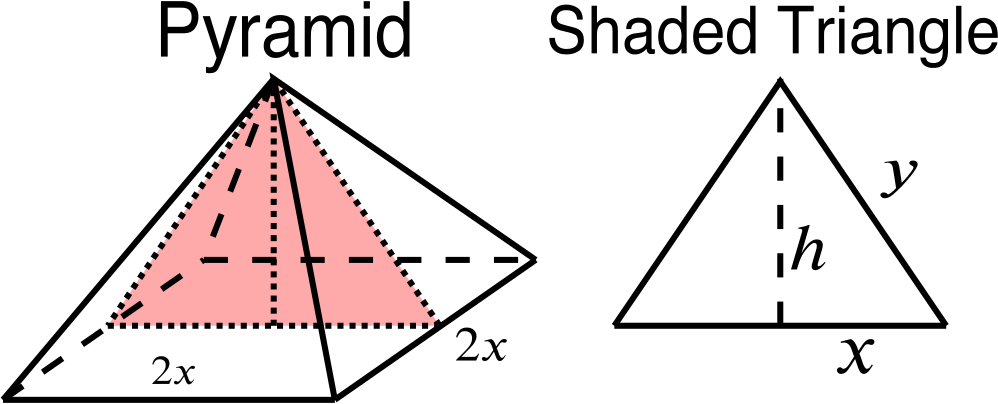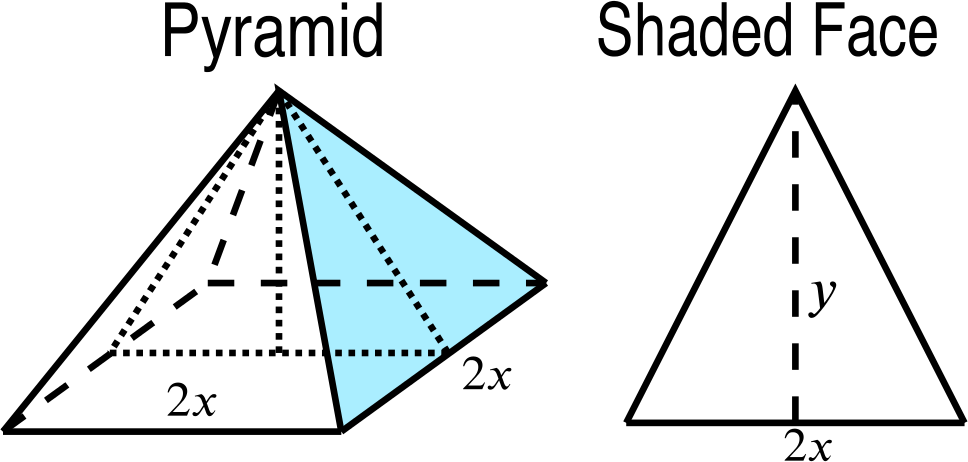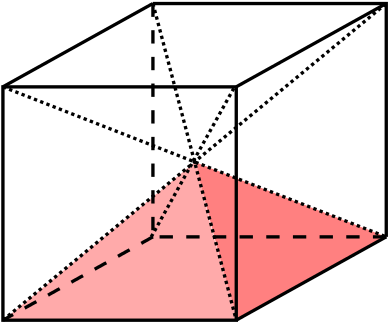A pyramid of given volume \(V\) stands on a horizontal square base of edge \(2x\), and its vertex is vertically above the centre of the base. Show that the area \(A\) of a sloping triangular face is given by \[A^2=\dfrac{9V^2}{16x^2}+x^4,\]
The volume \(V\) of a square based pyramid is \[V=\dfrac{1}{3}bh,\] where \(b\) is the area of the base and \(h\) is the height.
Our pyramid looks like this:

So we have \[V=\frac{1}{3}(2x)^2h.\]
We need to find the area of a sloping triangular face (which will be the same for all four faces, since the vertex is directly above the centre of the base).
For this, we need the height \(y\) of the face, which is related to \(h\) and \(x\) via \[y^2=h^2+x^2,\] which we can see from taking a vertical cross-section of the pyramid.

The area of the face is \(A=\frac{1}{2}(2x)y=xy\).

Therefore, \[A^2=x^2y^2=x^2(h^2+x^2)=x^2\left(\left(\frac{3V}{4x^2}\right)^2+x^2\right)=x^2\left(\frac{9V^2}{16x^4}+x^2\right)=\frac{9V^2}{16x^2}+x^4,\] as required.
…and prove that, as \(x\) varies, \(A\) is least when the face is equilateral.
We can say that \(A\) has a turning point if and only if \(A^2\) does, since we know \(A\) is positive and \(y=x^2\) is an increasing function for \(x > 0\).
If you know the Chain Rule for differentiating, you might think about \(\dfrac{d(A^2)}{dx} = 2A\dfrac{dA}{dx}\).
So considering \[\frac{d(A^2)}{dx}=4x^3+\frac{9V}{16}\frac{-2}{x^3}=4x^3-\frac{9V^2}{8x^3},\] we find stationary points when \(\dfrac{d(A^2)}{dx}=0.\) \[\Longrightarrow \qquad 4x^3-\frac{9V^2}{8x^3}=0 \qquad \Longrightarrow \qquad 32x^6=9V^2.\] There will be two real roots of this equation, one negative (which doesn’t interest us) and one positive, so there is one stationary point in the \(x>0\) region.
We know \[\frac{d(A^2)}{dx}=\frac{32x^6 - 9V^2}{8x^3},\] so if \(x\) increases slightly from \(\left(\dfrac{9V^2}{32}\right)^\frac{1}{6}\), then \(x^6\) increases slightly from \(\dfrac{9V^2}{32}\), (since \(y = x^6\) is an increasing function for \(x > 0\)), which tells us that the gradient of \(y = A^2\) is positive. Similarly if \(x\) decreases slightly from \(\left(\dfrac{9V^2}{32}\right)^\frac{1}{6}\), the gradient is negative.
So our single stationary point for \(x > 0\) must be a local minimum, and we know that \(A^2\) (and hence \(A\)) is minimized when \(x^6=\dfrac{9V^2}{32}\).
Now \(h^2 = \dfrac{9V^2}{16x^4}=\dfrac{9V^2}{32x^6}2x^2\), and so if \(x^6 = \dfrac{9V^2}{32}\), then \(h^2 = 2x^2\), and \(y^2 = x^2 + h^2 = 3x^2\).
So \(y = \sqrt{3}x\), and each face must be an equilateral triangle.




